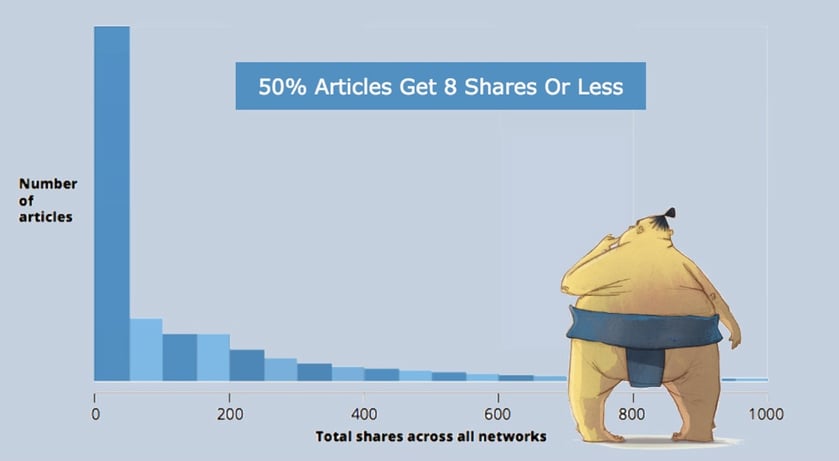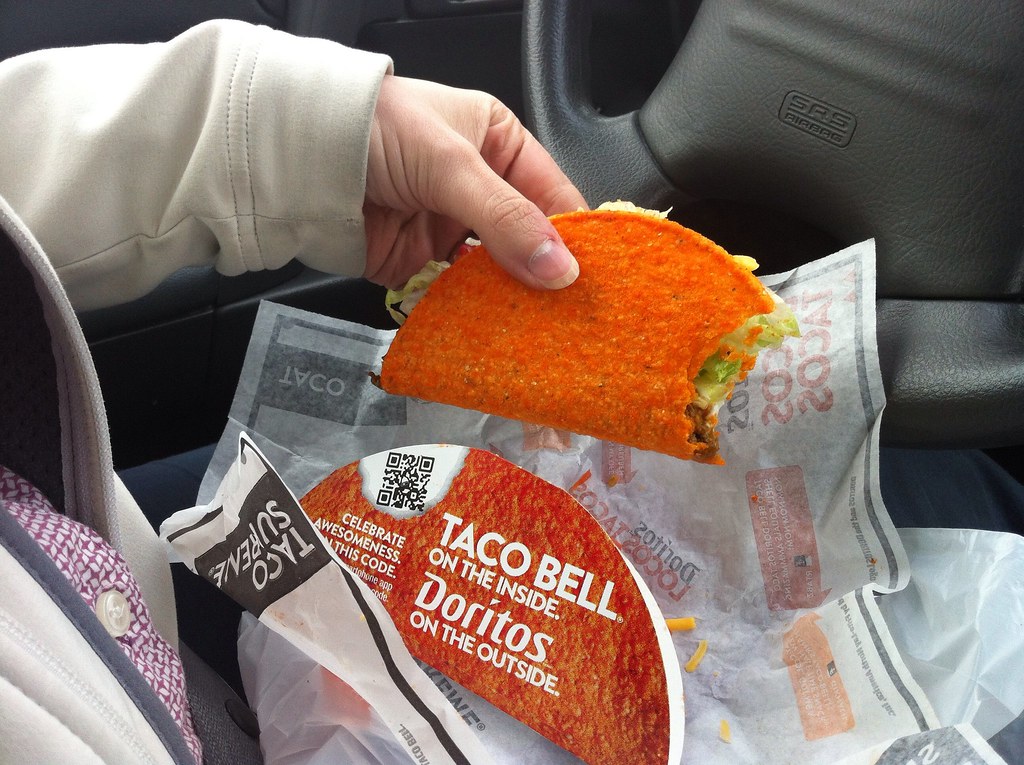
Whether you’re responsible for it or not,
Content Shock: A Primer
Content shock is the 14-year-old kid – Jerry – who walks out of his first Physics class dazed, confused, and glassy-eyed.
When you’re overwhelmed with stimuli – you can’t possibly process it all. If the pace of information thrown at you isn’t slowed, you’ll either become subconsciously desensitized or learn to be more selective about what stimulus you allow to register
If Jerry’s teacher refuses to come up for air between his or her rambling discussions on torque and velocity, it will either all meld into unintelligible background noise, or Jerry will only tune in for small, digestible snippets.
That’s content shock. Except instead of Jerry, it’s anyone with an internet connection. And instead of Physics, it’s all inbound marketing content. It should go without saying that this content overload presents a huge problem for digital marketers.
Been There, Done That
Ironically, this is the same type of problem that conventional marketers have faced and managed to live with, thanks in large part to a more inbound approach.
According to Jay Walker-Smith, President of the Marketing Firm Yankelovich, “we've gone from being exposed to about 500 ads a day back in the 1970's to as many as 5,000 a day today.”
On the face of it, that 10X increase might lead us to one of two simple conclusions:
- We’re all buying 10 times more stuff today, or
- Marketing is 10 times less effective.
Of course, such conclusions are the result of a binary thought process and reality is seldom so simple. The truth is much more nuanced than either of those options.
There are vastly more players in today’s marketplace than there were in the 1970s and many of those 5,000 daily marketing messages are self-cannibalizing. (Meaning that while you may be exposed to smartphone ads from Samsung and Apple, you’re not likely to buy two smartphones.)
Still, the reality holds shades of both options – A and B. More marketing has undeniably hardened the public to commercial suggestion – forcing marketers to work harder and be more innovative. While, at the same time, most of us have more products/services that we consider essential to our lives.
In other words, the marketing environment today is far more crowded and competitive than it once was. Attention spans are shrinking and while technology makes it easier to “reach” people, it’s disproportionately difficult to “touch” them. And despite this, great marketers are just as, and often more, successful than ever before.
What’s the significance of this strange dichotomy? Well, for our purposes, it tells us that there is life

Look Back To See The Way Forward
Remember, over the last 40 years the volume of marketing that
Hypothetically, it could have been avoided, but that was never going to happen. There’s a touch of game theory involved in this. If all us marketers would have acted with greater collective responsibility, we could have limited the flow of messaging and prevented marketing shock before it ever set in.
At the same time, since any individual marketer stands to gain by eschewing such a collective bargain and increasing his or her marketing in order to capture as much mindshare as possible before the impending shock, the problem persisted.
So, how did marketing survive the shock?
Over the last 20 years – first driven by the calloused responsiveness of audiences to traditional marketing and later prodded by the power-to-the-people impact of the Internet – advertisers began finding success with standalone value messaging.
Marketers slowly stopped selling the increasingly impotent promise of happiness emanating from a product/service and began selling humor, entertainment, or values in association with a product/service.
Early successes lead to strategic refinement and the Internet offered a perfect distribution channel.
Interestingly, the most successful marketers would now plug their wares in a distinctly indirect manner. They would give great content, usually in the form of honest information and expertise, to their target audience in exchange for their trust. (What I call the Miracle on 34th Street strategy)
Audience members would keep coming back for more helpful information until they decided they wanted to outsource the expertise. And I’m sure you can guess who they turn to once that decision's made.
This shift also saw message broadcasting replaced with message placement. Those not looking for the type of information included in a message would no longer be bombarded with it.
There’s little doubt that effective advertising was easier in the 1970s, but the pressure placed on the industry through marketing shock, forced it to adapt and refine its methods – ultimately making it better.
Whereas in earlier times, the airwaves were less crowded and people were more sensitive to persuasive arguments and associations, the modern marketer needs to stand out and speak the language of trust.
Inbound marketing has proven instrumental in doing just that. In fact, inbound marketing costs 62% less than traditional marketing while generating three times as many leads per dollar spent. Quite a windfall, when you think about it. Only the past is now repeating itself.
Now Put It All Together
Late last year BuzzSumo released a report that shook the inbound marketing world. Titled, 50% of Content Gets 8 Shares Or Less: Why Content Fails And How To Fix It, the report analyzed one million articles to see what content drives engagement and to what extent. As you’ve likely surmised from the title, the findings were grim.

This excerpt nicely captures the core of the report:
“Whilst in earlier years it was possible that if you produced good content it would get found and shared, almost by virtue of its quality, this is no longer the case. There is now so much content that even producing great content is not enough. The bar is way higher. Popular sites with great content are also being affected by content shock.”
Having avoided the worst of traditional marketing’s content shock by settling a new frontier with inbound, marketers now have to come to grips with that selfsame frontier being threatened anew by shock.
Many are observing this trend and predicting the imminent demise of content marketing. They say the practice is unsustainable and designed to fail. They’re wrong, of course.
Just like inbound marketing didn’t sound the death knell for traditional marketing, this new wave of content shock will only push for more evolved marketing methods.
Those marketers who adapt to withstand and work around the shock are destined for a bigger slice of a growing pie. Those who don’t, well they can always be Uber drivers.
Here are five tips to get you through what may be a difficult market transition ahead:
1. Never ever publish anything that’s okay
Okay is a four-letter word. I can’t tell you how often I hear that word used to describe content that’s just not very good. If you’re pumping out content that you know falls short of great, you’re part of the problem.
Thanks to SEO factors, it’s really difficult to achieve visibility without wielding an extensive content arsenal. Most marketers know this and conclude that content volume must be a key component to a successful inbound strategy.
That’s a mistake. If you’re visible but only okay, few of your visitors will return and almost none will convert. If you don’t already have a large, quality content library, it’s much better – for the time being, at least – to rely on paid media techniques to improve your visibility while you work to produce the sort of content that’s worth seeing.
If you’re known for quality by whomever
2. Embrace non-textual communication
Shock results from content overload. A great workaround to that shock is operating outside of the overload flow. Specifically, in the case of content marketing, the vast majority of content overload is textual.
By communicating your value non-textually, you can avoid Jerry’s glassy-eyed gaze – instead sparking and instantly capturing his attention. Essentially, a non-textual strategy allows you to operate outside of content shock.
Consider greater and more creative use of images, infographics, videos, interactive content, webinars, podcasts, etc.
Not sold on the value of non-textual content? Did you know that 90% of information transmitted to the brain is visual – and visuals are processed 60,000 times faster than text? How about the fact that viewers spend 100% more time on pages with videos on them?
If your content strategy relies solely on text,
3. Talk to your community
If you don’t want to be lost in an ocean of content, you can always write for someone in particular or about something not already out there. Extra points if you can manage both those feats in one fell swoop.
No matter who you are and what you do, there’s sure to be interested. It may be your peer group, your digital network, your business supporters, or your target customers – either
If three people answer, chances are strong that they represent 50 who didn’t. Even if they don’t, take their lead. When it comes time to publish, try to refer to them in the post itself (with permission) and then encourage them to promote the content through their own social channels – on and offline.
If you initially reached out to your community through Reddit, Facebook, Linkedin, Quora, Pinterest, whatever – be sure to follow through within those networks, directing followers to your post. In so doing, you’ll exert ownership over a designated distribution channel and cut past the content shock.
This will help keep your content program in touch with its audience, accessible, and with a devoted stream of visitors. In short, it helps shock-proof your content.
4. Build a partnership content strategy
If content shock makes us all a little weaker, it stands to reason that joining forces could present an easy way to compensate. Not only that, but it helps diversify your brand appeal by branching out to different markets.
 Cobranding content is a great strategy because it’s mutually beneficial, prevents an overly promotional feel and can serve as the foundation for a broader strategic partnership.
Cobranding content is a great strategy because it’s mutually beneficial, prevents an overly promotional feel and can serve as the foundation for a broader strategic partnership.
You extend your reach, boost your brand recognition, and increase your credibility by association. If you play your cards right, it can also be a boon for your PR. These are all potent countermeasure against the effects of content shock.
Think about the traction Disney’s gotten out of their work with
5. Prevent your own content shock
Most marketers are totally oblivious to the threat of internal content shock. Regardless of everything else that’s out there, once someone is on your site or following you on social media you have his or her attention. That
There are two ways you can lose people's attention at this point. You can overload them with content and
This is different than the other tips because it applies equally to your social media and promotional messaging as it does to your content itself.
Either way, the result is the same: Self-made content shock. This needs to be avoided at all costs. The good thing is that you’re in complete control and can easily steer your ship to success.
It should go without saying, as per tip number 1, that if you’re flooding your digital real estate with bad content, you need to stop immediately.
Some marketers might disagree with the rationale of my internal content shock warning, arguing that per item engagement may decrease but total engagement will always be higher with more content.
Even provided consistently good content, that’s just not true. If it helps, think about it in terms of the Laffer Curve. If you’re overtaxing your audience’s limited attention span, it’s
Perform an analysis to determine if you’re posting too frequently on your social channels. Likewise, you’ll need to test whether the publication of a new blog post interferes with older pieces reaching their saturation points.Now, I can’t say for sure what side of the Laffer Curve you’re stuck on, but if you thought
The bounds of internal content shock vary from industry to industry and case to case, but these are some generalized best practices:
- After two tweets in a
day you can expect diminishing marginal returns, while total returns top out at 30. - It’s not recommended to post
to Facebook more than two or three times a day. - 20 posts a month is the standard recommended output volume for LinkedIn.
- Recommended blogging frequency varies wildly depending on the size of your organization and whether your offering is B2B or B2C oriented. For a detailed breakdown, see here.
It’s a lot to chew on, I know. But this may well save you from falling victim to content shock. Some historical perspective and these five tips should go a long way. Godspeed!
--------
Download your FREE Content Marketing Bible here >>

by The Penguin Team on February 07, 2016
As a leading B2B digital marketing agency, We help B2B Technology Companies, enterprise software, and hardware companies increase brand awareness, reach more qualified leads and close more customers. Penguin Strategies is a Diamond Partner of HubSpot.





